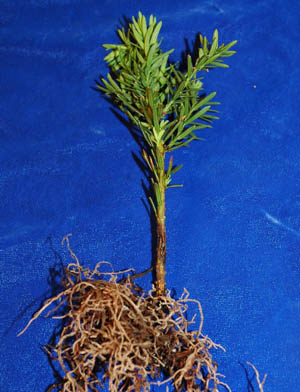Phytophthora Diseases | |
|---|---|
| July 3, 2006 | |
|
There is no getting around that fact that Phytophthora diseases have been and continue to be devastating to plants around the world. The Phytopthora pathogen that usually comes to mind as the most devastating in history is Phytophthora infestans, which causes late blight of potato. As many are aware, this pathogen infected potatoes across Europe in the 1840s, which resulted in mass famine, and immigration of many of our relatives to this country. Scientists still struggle to control this disease. Unfortunately, there are many Phytophthora species that infect a wide range of plant hosts, including fruits, vegetables, and ornamentals. Fortunately, they are not all as devastating as potato blight. To date, about 60 species of Phytophthora have been identified. Phytophthora species are in the oomycete group of fungi, often referred to as the water molds. Some other oomycete diseases that you may be familiar with are those caused by Pythium and downy mildew pathogens. The new classification of the oomycetes identifies these plant pathogens as similar to fungi; however, they are considered to be more like protists, a closely related class of organisms, rather than the true fungi. The reason for this is that oomycete pathogens produce fast-swimming spores called zoospores that require “free water” for infection. So if you see oomycetes labeled as fungal-like, do not be alarmed. This is just a classification change. Phytophthora species are considered to be soil-borne pathogens and can remain dormant in the soil for many years until conditions are conducive for infection. Because Phytophthora is a pathogen that produces a spore that requires water for movement, it follows that these diseases are favored by wet conditions. Phytophthora species may attack susceptible plant hosts in times of wet weather or on sites with poor drainage. Symptoms of Phytophthora diseases depend on the specific Phytophthora species and the host. We usually think of Phytophthora as a plant disease that occurs below ground and infects the roots and crowns. Some Phytophthora species attack small seedlings and cause “damping-off.” Plant hosts may have some resistance to Phytophthora, and only mild root rot and slight stunting of foliage may occur. These symptoms could go unnoticed by the grower. On the other hand, Phytophthora may cause a severe root rot and the aboveground foliage could have symptoms such as yellowing, wilting, stunting, or intervenial chlorosis (nutrient-deficiency symptoms). The first symptom of Phytophthora on most susceptible plants is the blackening of the stem, from below ground to several inches above ground. The images of an infected pepper plant and an infected yew show this common symptom.   If the darkened area of the stem is cut open, the inner tissue will also be dark. If the darkened area of the stem is cut open, the inner tissue will also be dark. There are Phytophthora species that infect the aboveground plant parts and are called aerial Phytophthoras. As you might expect, these aerial Phytophthoras occur in wet or humid conditions. There has been much concern recently about Phytophthora ramorum, the cause of sudden oak death (SOD) or Ramorum blight. This pathogen can cause aerial blight and stem dieback on a number of nursery crops. If you are interested in seeing a list of hosts affected by P. ramorum, visit http://www.aphis.usda.gov/ppq/ispm/pramorum/pdf_files/usdaprlist.pdf. There are also Phytophthora species that cause buds and fruits to rot. Another symptom that may not be as common is “bleeding cankers” on some tree species. In Illinois, the root and crown rots are more common. If you suspect a Phytophthora infection, the University of Illinois Plant Clinic is now equipped to perform an enzyme-linked immunosorbent assay (ELISA), which allows for quick detection of the pathogen. Please refer to http://plantclinic.cropsci.uiuc.edu/ for payment information. The control of Phytophthora diseases almost always requires an integrated approach; and the control recommendations, of course, depend on the plant species that is infected. There are several fact sheets in the University of Illinois series Report on Plant Disease dealing with Phytophthora diseases. Visit this site to view the possibilities: http://www.ag.uiuc.edu/%7Evista/horticul.htm. (Stephanie Porter and Nancy Pataky) |